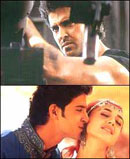No business in show business
By Probir Roy | 14 Jan 2003
 Mumbai: Dorothy Fields may have scripted the line “There is no business like show business” in her famous Broadway play Annie Get Your Gun, but there is no doubt that the operative word in the fun, glamour and glitzy entertainment world is business. Keeping all spectators in good humour and bringing joy into their lives is serious business.
Mumbai: Dorothy Fields may have scripted the line “There is no business like show business” in her famous Broadway play Annie Get Your Gun, but there is no doubt that the operative word in the fun, glamour and glitzy entertainment world is business. Keeping all spectators in good humour and bringing joy into their lives is serious business. The year gone by has been touted by analysts, scribes and practitioners alike as one of the worst in Bollywood history - just two or three hits out of the 220-odd films released; $60-million loss; numerous borderline cases; the demise of Bhagat Singh genre film-making and release strategies; and the fading away of Hrithik Roshan.
And what about Hollywood? The largest take at the domestic box-office at over $9 billion; 22 movies crossing the $100-million mark and seven the $200-million mark; attendance a full 5 per cent higher though ticket prices were higher than the previous year.
 Even a sleeper movie with a shoestring budget and a limited release like DrumLine grossed $50 million. Salomon Smith Barney of CitiGroup predicts: “Entertainment and recreational spending worldwide will continue to grow as a share of personal consumption…” So much for 9/11 and global recession.
Even a sleeper movie with a shoestring budget and a limited release like DrumLine grossed $50 million. Salomon Smith Barney of CitiGroup predicts: “Entertainment and recreational spending worldwide will continue to grow as a share of personal consumption…” So much for 9/11 and global recession.
Certainly what is good for the Hollywood goose is not sauce for its Bollywood counterpart, and therein lies the opportunity. Unlike software, IT-enabled services and many export-oriented sectors, the media and entertainment (M&E) sector in India is not dependent on the vagaries of the world market, namely the US market, that great big market driver for other-brethren sectors.
Our own making
It is clear that the M&E sector has a momentum and locomotion of its own, which is heartening in an otherwise highly interdependent world. To some extent the troubles have been of its own makings with certain shortsightedness, quick-in-the-can release strategies, underlying poor storylines, creativity, me-to positioning, and the proverbial quick-buck syndrome.
There is a silver tola lining to each cloud:
- A 15-per cent growth rate, three times the national gross domestic product (GDP) growth rate, and one of the fastest-growing service sub-sectors.
- The success of crossover movies and the emergence of crossover audience.
- English movies doing better at the box-office than its local counterparts.
- The second Dadasaheb Phalke Award to the Chopra family.
- The emergence of the younger and professionally educated generation of actors, directors and producers.
- The entry of overseas companies for production and distribution.
- The corporatisation of the production and exhibition value chain
- The formation of the animation special interest group (hopefully to encompass the gaming folks too, few as they are).
- The advent of the infotainment and enter-tailing concepts with the launch of online and brick-and-mortar switches, web-stores, PVRs and multi- and mega-plexes , complementing the ongoing infocomm and retail revolution in the country.
- The belated adoption of a single TRP measurement system (TAM-ADEX).
- Double digit TRPs being the rule rather than the exception.
- Super bowl type 20-second ad rates.
- The competitiveness of viewers’ choice, be it news, sports or soap.
- The music over FM radio.
- The worldwide release of new songs officially to forestall piracy.
- The ultimate Indian music machine, Bombay Vikings, Agosh or Dewang Patel.
- TeamWork Films, the Indian live events firm, carrying Indian art and culture beyond our shores.
SWOT analysis The year gone by with 20/20 hindsight can be best described as a year of natural transition to the next stage of growth. The opportunities are many, and naturally occurring. And what does one foresee in the coming months?
The year gone by with 20/20 hindsight can be best described as a year of natural transition to the next stage of growth. The opportunities are many, and naturally occurring. And what does one foresee in the coming months?
Certainly the movie industry will come up with better ‘stats’ than the year gone by, thus keeping scribes and analysts happy. Audiences, though fragmented and demanding, will drift back to big and small screens for their 90-minute instant gratification. The rural markets will still define the ultimate box-office hit, while the hip urban markets continuing to reflect the growing aspirational needs of urbane markets.
Production values will revolve around solid storylines, scripts and writers (yes, writers). The small-budget strong storyline and screenplay, low profile yet talented cast and rival marketing will endorse the soundness of the basic principles of business for small-medium filmed entertainment, while its big-budget counterparts stretch it.
My optimism lies around a few basic simple tenets. Firstly, the urge for constant renewal and creativity that is in abundant quantity, whether it be an x, y or z. Creativity and success alike have a short shelf-life and are much like a perishable product. One can’t rest on past laurels. Both the younger generation, without baggage and egos, and veterans deal with these on a day-to-day basis for survival.
Individual success counts One can’t pass on automatic ‘success’ like in the brick-and-mortar world; Sunil Gavaskar’s son may never play for India or be a world-class batsman; Vivek Oberoi has no god- or board-given right to ‘hit’ movies. While genetics and lineage may at best provide advantageous access, they will just as need to struggle and strive for ‘success’ based on their own performance as any other. The markets and fans are ruthless (read unpredictable) in whom they want to see heroes. And who zeroes.
One can’t pass on automatic ‘success’ like in the brick-and-mortar world; Sunil Gavaskar’s son may never play for India or be a world-class batsman; Vivek Oberoi has no god- or board-given right to ‘hit’ movies. While genetics and lineage may at best provide advantageous access, they will just as need to struggle and strive for ‘success’ based on their own performance as any other. The markets and fans are ruthless (read unpredictable) in whom they want to see heroes. And who zeroes.
Secondly, few world economies are capable of achieving a 5-per cent growth rate year on year. And with corporate resurgence on the cards (with impressive second-quarter sales-and-profit growth numbers) these are positive indications of things to come. While the M&E is certainly no apparel sector (3 per cent of the GDP, 24 per cent of India’s exports, 30 million employed), by itself has a growth rate three times the national GDP. And with half the growth rate of its popular cousin, the software sector, it is perhaps the highest performing sub-sectors today.
It has more potential for creating assets and intellectual property rights of long-lasting significance and more so of uniquely Indian and intergenerational value. The global majors that track this industry are also publicly bullish on the $3-billion domestic industry with the likes of the Rabo Bank, McKinsey, IBM-PwC, Ernst & Young, JM Morgan Stanley and the likes being fairly optimistic on the potential growth of this sector in the next five years.
 Thirdly, the Indian diaspora of 20-million people who reside overseas has an earning power twice that of the vibrant Malaysian national economy. And by itself is a huge market for consumption and investment opportunities (20 per cent of foreign exchange reserves are contributed by non-resident Indians [NRIs]).
Thirdly, the Indian diaspora of 20-million people who reside overseas has an earning power twice that of the vibrant Malaysian national economy. And by itself is a huge market for consumption and investment opportunities (20 per cent of foreign exchange reserves are contributed by non-resident Indians [NRIs]).
Parting shot
Fourthly, worldwide this $1-trillion market is expected to grow at a compounded annual growth rate of 5-6 per cent, with Asia (India, Korea and China) expected to be one of the fastest-growing regions. The tight coupling of the ongoing telecommunications, Internet and digital broadcasting and distribution revolutions prevalent in these economies will perforce speed up the overall access, adoption and acceptability, and propel media products and service innovations into the homes, minds and wallets of the citizens of these countries.
Fifthly, at the human level it is painfully open and aware of its own shortcomings without too much misplaced sentiment - across all vintages and media assets. This acknowledgement itself provides half the solution; the other half coming from an executive belief that they also know what needs to be done to carry out mid-course correction.
And many of them are indeed charting their fresh courses. One does not see this can-do attitude in too many other sectors (ever dependent on the government and ‘level-playing field’ syndrome as they are) including the over-publicised and, perhaps some say, the mollycoddled IT service sector.
And the Indian film industry (all languages, dialects, genres, including crossovers and hybrids), the engine of growth for the M&E sector, continues to chalk out ambitious plans for over 60-odd new film releases in the next two months.
Year 2003 will perforce need to be the year for the essential optimist.





















